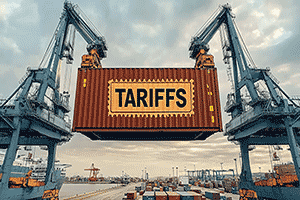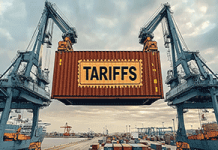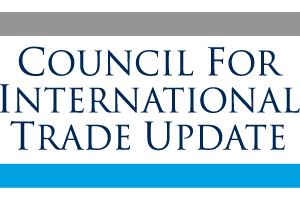 Following are answers to common questions about the impact tariffs have on the U.S. and California economies.
Following are answers to common questions about the impact tariffs have on the U.S. and California economies.
• How can tariffs affect trade between two countries (in a general sense)?
The California Chamber of Commerce continues to voice concern about tariffs and any other actions that create uncertainty and increase the cost of doing business for California entrepreneurs. The CalChamber has long been committed to supporting a national free trade agenda that fosters economic growth and job creation.
The CalChamber will continue to focus on lowering and eliminating tariff and nontariff barriers to support the expansion of American exports. While strategic use of tariffs or the threat of tariffs may be a meaningful negotiation tool, the CalChamber supports efforts to reduce taxation and regulatory burden as a means to create jobs and economic growth. Further, a focus on free trade agreements instead will ultimately lower both tariff and nontariff barriers and help create long-term, sustainable economic growth.
The CalChamber opposes protectionist measures (including the raising of tariffs) which create uncertainty, disrupt global supply chains, raise consumer prices, limit choices of products for consumers, hinder the competitiveness of California businesses, and invite retaliation.
The California Chamber of Commerce, in keeping with longstanding policy, enthusiastically supports free trade worldwide, expansion of international trade and investment, fair and equitable market access for California products abroad and elimination of disincentives that impede the international competitiveness of California business.
• How are states affected by U.S. international trade agreements? Has California been affected?
Traditional and existing/long-standing U.S. free trade agreements (FTAs) translate into the removal of billions of dollars in tariffs and nontariff barriers for U.S. exports. The United States is among the world’s leading exporters due to increased market access achieved through free trade agreements.
Current U.S. free trade agreements are: U.S.-Australia; U.S.-Bahrain; U.S.-Chile; U.S.-Colombia; U.S.-Dominican Republic/ Central American; U.S.-Israel; U.S.-Jordan; U.S.-Mexico-Canada Agreement; U.S.-Morocco; U.S.-Oman; U.S.-Panama; U.S.-Peru; U.S.-Singapore; and U.S.-South Korea.
In 2024, exports to FTA markets accounted for 43.01% of California exports. California exports to FTA partners totaled $78.86 billion in 2024. (Source: International Trade Administration)
The CalChamber believes strengthening economic ties and enhancing regulatory cooperation through free trade agreements with our top trading partners that encompass both goods and services, including financial services, is essential to eliminating unnecessary regulatory divergences that may act as a drag on economic growth and job creation.
The CalChamber seeks commercially meaningful outcomes in negotiations with regions around the world and supports bilateral, regional and multilateral trade agreements, which are critical to consumers, workers, businesses, farmers and ranchers, and would allow the United States to compete with other countries that are negotiating agreements with each other.
• How important is international trade for maintaining economic stability in California? Why?
The U.S. Department of Commerce reported that, in 2024, California goods exports amounted to $183.34 billion. This was an increase of roughly 2.5% from the previous year’s total of $178.84 billion. Further, goods exports from California account for nearly 9% of total U.S. goods exports.
Although trade is a nationally determined policy issue, its impact on California is immense. In 2024, California exported to over 225 foreign markets. Trade offers the opportunity to expand the role of California’s exports. In its broadest terms, trade can literally feed the world and raise the living standards of those around us.
California’s top export markets are Mexico, Canada, China, Japan and Taiwan.
• Since Trump’s tariffs have been in place, has California’s international trade been affected?
Yes, not only has trade been affected, but also tourism, which is classified as an export.
The California tourism industry, represented by Visit California, is facing challenges due to the impact of tariffs and related federal economic policies.
Specifically, while California’s tourism spending reached a record high of $157.3 billion in 2024, Visit California expects a decline in overall California visitation and a downturn in international tourism in 2025.
• Although tariffs are placed on imports, have recent tariffs on other countries posed a threat to California exports to certain countries like Mexico or China where they have now placed tariffs on American goods in response to our tariffs?
The biggest threat is retaliation by our trading partners.
Gov. Gavin Newsom has directed his administration to pursue new strategic trade relationships with international partners aimed at strengthening shared economic resilience and protecting California’s manufacturers, workers, farmers, businesses, and supply chains. As part of this effort, the Governor is also calling on long-standing trade partners to exempt California-made products from any retaliatory measures, as California agriculture and manufacturing have much to lose from a trade war.
• Has the amount of cargo (in exports and imports) been affected at the ports in California from the tariffs?
Yes, the much discussed “whipsaw” effect has been prevalent since the first mention of tariffs being imposed. Bottom line: This has caused uncertainty and a stop and start in flow of goods.
• How does all of this affect California business domestically?
California is now the fourth largest economy in the world with a gross state product of more than $4 trillion. International trade and investment are major parts of our economic engine that broadly benefit businesses, communities, consumers and state government. California’s economy is diverse, and the state’s prosperity is tied to exports and imports of both goods and services by California-based companies, to exports and imports through California’s transportation gateways, and to movement of human and capital resources.
Staff Contact: Susanne T. Stirling

